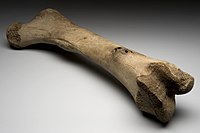
Photo from wikipedia
Currently, most in vitro engineered bone tissues do not contain viable blood vessel systems, so the vascularization depends on post-implantation angiogenesis from the host, which is often insufficient for repairing… Click to show full abstract
Currently, most in vitro engineered bone tissues do not contain viable blood vessel systems, so the vascularization depends on post-implantation angiogenesis from the host, which is often insufficient for repairing large bone defects. In this study, we aimed to create pre-vascularized bone-like tissue from human bone marrow-derived mesenchymal stem cells (HBMSCs) within the self-generated extracellular matrix by simulating the developmental endochondral ossification. Afterward, a three-dimensional (3D) culture of human umbilical vein endothelial cells (HUVECs)/HBMSCs was introduced to cover bone-like constructs surface for vascularization. Lastly, the pre-vascularized bone-like tissues were subcutaneously implanted into mice and the quality of newly formed blood vessels and bones were later assessed. We particularly examined whether the pre-existing HUVECs/HBMSCs vascular networks within the implants were able to integrate with the host's blood vessels and facilitate bone formation. Our results showed that this developmentally informed procedure resulted in a robust osteogenic differentiation of HBMSCs. Moreover, the bone-like constructs markedly promoted HUVEC/HBMSCs network formation in vitro. After 28 days of implantation in mice, the experimental group, in which bone-like constructs were pre-vascularized with HUVEC/HBMSCs networks, exhibited significantly more functional blood vessels than the control group that contained HUVEC and HBMSC single cells. Interestingly, increased levels of bone formation and absorption markers were also observed in the pre-vascularized bone-like constructs. Taken together, these findings demonstrated the potential of pre-vascularized bone-like constructs in repairing bone defects.
Journal Title: Biomaterials
Year Published: 2022
Link to full text (if available)
Share on Social Media: Sign Up to like & get
recommendations!